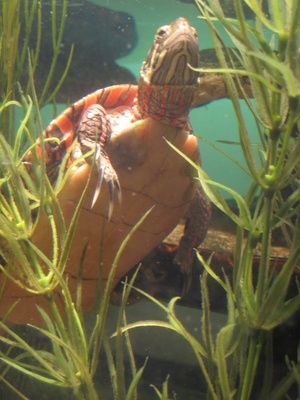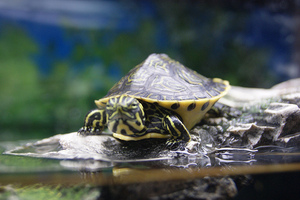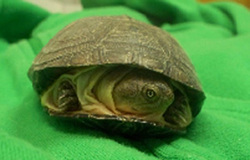A vet's first pet: Learning how to care for aquatic turtles

Lyssa Alexander | Contributor
I volunteered in the Michigan State Wildlife Rehabilitation program during my first year of veterinary school. It was an amazing experience. We worked with hawks, eagles, ducks and occasional small mammals. I had only seen one turtle shell repair during my first year, but apparently that was enough in the eyes of our supervising veterinarian.
During the last month before summer break a painted turtle with multiple shell fractures and blood inside his eyes came in to the wildlife center. The head vet turned to me right before he left for the whole summer and said, “You’ve got this one.”
I was overcome with a sudden sense of panic — this was my first patient! I felt completely unprepared. After one year of vet school, I could tell you about dog anatomy and basic physiology, but I had not idea how to treat complex injuries to a wild turtle. Sometimes you just have to learn by doing.
He was a roughly 2 or 3-year-old male painted turtle. He had been found on the side of the road (most likely run over by a car) and had two large cracks in his shell- one on top and one on bottom. His right arm was limp and the front of his eyes were filled with blood.
I repaired his shell and set him up with a suitable aquatic environment. I hand fed him and exercised his legs while waiting for the blood in his eyes to resolve. Once it was nearly gone, I took him down to the veterinary eye specialists.
They told me that both of his retinas were completely detached and that he was unlikely to ever see properly. This was a huge blow for me, because a blind turtle is not a candidate for release into the wild.
Normally an un-releasable wild animal will be euthanized, but I couldn’t bring myself to do it. This was my first patient ever. So, he is now my pet. In general it is not a good idea to take animals from the wild and keep them for pets. Many species of turtles in Michigan are protected, and collection of any turtles for the pet trade is highly discouraged. I called the DNR to make sure it was OK for me to keep him, and they were fine with it in this particular situation.
My turtle (Grom) has been living with me for many years now. He is well adapted to life as a blind turtle. He gets hand fed every other day in a special feeding tank.
Just to make sure that he was truly not able to forage for himself in the wild, I put a tiny goldfish in the tank with him — he was oblivious. The goldfish survived and is still swimming around in there with him today (the fish is now three times the size of the turtle’s head).
Once I decided to keep him, I did a lot of research about caring for aquatic turtles, and this knowledge has served me well in my career as a veterinarian ever since.
Care of aquatic turtles

Photo by Flickr user Kevin Timothy
Housing:
A small turtle needs a tank that is at least 30 gallons, and a large turtle needs at least 70 gallons or even a small pond. Do not put gravel/pebbles in the bottom because they trap algae and bacteria. You can leave the bottom as just plain glass and add a few large decorative rocks. They should have at least one land area where they can get their entire body out of the water to bask under a heat lamp.
They also appreciate shallow areas where they can rest but still remain submerged- these can be created with large rocks or aquarium pieces.
Water:
The water should be at least two times deeper than the length of their shells. Ideal water temperature is 75-85 degrees (all tanks need thermometers).
The water should be changed completely every two weeks, and 50 percent of the water should be changed out every three to four days in between big cleans. During the big clean, all decorations should be removed and scrubbed. This is labor intensive but very important. I spend one or two hours on this every single week.
An underwater filter is also needed to keep the water clean in between cleanings. A lot of people think they can just put a turtle in a tank and forget about it until it looks gross, but this can lead to dangerous build-ups of algae, bacteria and ammonia.

Lyssa Alexander | Contributor
Lighting:
Your turtle’s basking spot should reach 85-90 degrees. This can be accomplished with a 100-watt bulb and a clamp lamp, but make sure to check it with a thermometer. They also need to have a UV B bulb — without this, they can get severe bone disease (you will know you are buying the right bulb because it will be expensive and say UV A/B or UV B on it). Both lights should be on for 10-12 hours/day (I recommend a timer).
It is a great idea to get them outside into natural sunlight regularly — do not leave them unattended and do not leave them in a glass enclosure in the direct sunlight (a children’s pool with a screen on top is perfect).
Food:
Floating turtle pellets are a staple part of their diets. It is best to feed them in a separate small feeding tank to keep things clean. A large part of their diets should also consist of leafy greens (red/green leaf lettuce, kale, mustard greens).
Keep offering these to your turtle every time they feed, even if they don’t seem to like them at first; it took me seven months to get my turtle to eat them. They can also eat occasional treats such as crickets, small feeder fish and earthworms (all store bought —you don’t want parasites).
Dr. Lyssa Alexander treats small and exotic animals and pocket pets at All Creatures Animal Clinic.


Comments
hypsi
Fri, Jul 22, 2011 : 2:07 p.m.
Thank you for this article! I had a two turtles for over 15 years that lived in an 100 gallon tank with a huge Koi and an albino underwater frog in the spring they used to "talk" to each other. Being more of a nature girl, those turtles brought me many years of happiness with their conversations. Having them brought back many memories growing up, having the windows open and being able to listen to the wild turtles talk to each other in the pond and river near my house. I used to let them out in the summer in an enclosed area in my yard, they used to follow me around. Merytle used to cross the road and hang out in the neighbors pond, but every evening she would come "home" RIP Yertle and Merytle...turtles are smarter then you think!